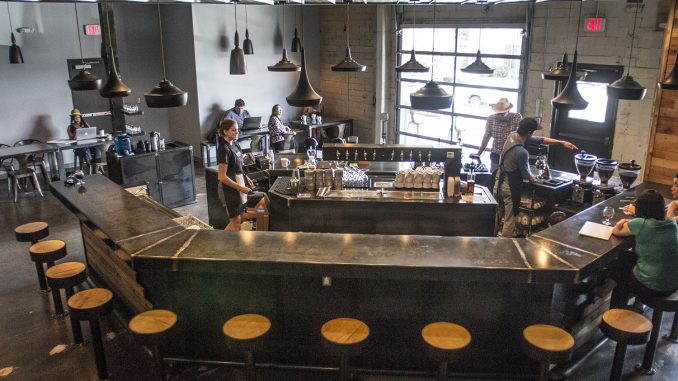
By Jeremy Martin
SPECIAL TO BARISTA MAGAZINE
The culture of the specialty-coffee café has always been synonymous with cool ”from the style of the spaces, to the innovative buying practices of the roasters, to the equipment and brewing methods utilized in the space. One thing, however, has remained stagnant: the flow of the coffeehouse.
œNothing has changed since the inception of the modern espresso bar, says Mike McKim, owner of Cuvée Coffee in Austin, Texas. œIt goes: walk up to the register, pay, and go get your drink, When my wheels started turning was when I first went to a place like Chipotle where you walk up and you build your food along the way, and you pay at the end.
Mike’s idea was to take the customer-flow principles found at fast-casual dining establishments and transfer them into a café.
œAt a fast food restaurants and most cafés, you pay at the register and go get your food, but it seems like the fast causals, the ones that are a step beyond fast food, they’re doing it the opposite way, Mike says.
Much like the ordering process they may be used to from a sub sandwich or burrito shops, the system at the new Cuvée Coffee Bar at 2000, E. 6th Avenue in Austin, puts customers in the drivers seat through the entire ordering process.

Here’s how it works: Once a customer enters the café, he approaches a barista standing at an espresso machine. This is where the customer can choose what kind of espresso he wants used ”typically, Cuvée offers at least three different blends and/or single origin offerings.
Next, the customer moves on to the milk station, where a second barista will steam milk for whatever espresso drinks are in the order, and add ingredients (such as chocolate for a mocha, etc.). Finally, the customer will approach a third barista for ordering anything else, such as a pastry or juice, and have his order rung up on a register.
“The way the bar is designed is [that after you order your espresso], you have to physically turn a corner to get to the next barista who steams the milk, says Mike. œIt’s really compartmentalized.
Mike says the new bar set up is far more efficient both for baristas and consumers, though new customers will still often need a quick lesson in how to order and pay. Luckily, Cuvée had the foresight to create cheat sheets for this.

œAs soon as they walk though the door, people will see the POS system at the end of the bar and make a beeline for that, and they’ll have to kind of be brought back to the very beginning, Mike says.
The café was designed by local architect Stephen Oliver, who used low sight lines and equipment mounted below the bar ”Modbar! ”to create a roomy, inviting, and interactive atmosphere. Patrons can either sit at tables that line the walls, or on stools at the bar. Take that word ˜bar’ to heart: beer fanatic Mike included a terrific beer selection on tap at the new space, and he wants customers to feel as comfortable sipping coffee at Cuvée as they do drinking a beer.
œDesigning it to have a bar feel was really important because since we serve beer and the beer program is equally important as our coffee program, I didn’t want people to think a) they’re drinking coffee in a bar, or b) they’re drinking beer in a coffee shop, Mike says. œPart of the vision was to create a space where it didn’t feel different whether you come in at 8 o’clock in morning or 8 o’clock at night.

The café itself opened in late August, but had been in the works for nearly three years as Mike and his team perfected the idea and sought a retail location that would fit their needs.
Though the concept has already outclassed Mike’s expectations, he says he has no plans to replicate the concept in other spaces at the moment ”not that it’s kept him from being asked.
œThe first week we opened, somebody called fro Oregon wanting to know all about the Modbar, loved the setup and wanted to know if we could help them do that, says Mike. œOur sales manager gets a ton of calls about that.
ABOUT THE AUTHOR
Jeremy Martin is a freelance writer and photographer who has reported on coffee, craft beer, college sports, and business for a variety of publications over the past six years. A veteran of the café industry and graduate of Western Michigan University, Jeremy lives in Seattle where can often be found making sandwiches from whatever is left in the fridge and cracking wise for the amusement of his adoring wife Amanda.



I don’t know if I’d call this ‘changing the tide’.
Espresso Vivace in Seattle has had a similar setup essentially since their inception (25+ years ago).
Also, Milstead & Co in Seattle, Ritual in San Francisco, and to my understanding Scarlet City’s new bar in Emeryville, all operate with similar concepts of bar flow.
That said, I do appreciate seeing more cafes picking this up as the far more rational organization of customers it is.